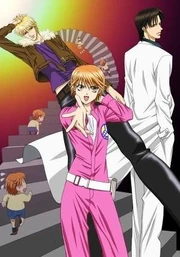No edit summary |
No edit summary Tag: Visual edit |
||
| (5 intermediate revisions by 3 users not shown) | |||
| Line 2: | Line 2: | ||
[[File:Skip Beat.png|thumb|[[Skip Beat]], a shōjo manga]] |
[[File:Skip Beat.png|thumb|[[Skip Beat]], a shōjo manga]] |
||
| − | The term '''shōjo''', '''shojo''', or '''shoujo manga''' (少女漫画, ''shōjo manga'') refers to [[manga]] marketed to a female audience roughly between the ages of |
+ | The term '''shōjo''', '''shojo''', or '''shoujo manga''' (少女漫画, ''shōjo manga'') refers to [[manga]] marketed to a female audience roughly between the ages of 12-18. The name romanizes the Japanese 少女 (shōjo), literally: "little female". Shōjo manga covers many subjects in a variety of narrative and graphic styles, from historical drama, to [[Yaoi|boys' love]], to science fiction — often with a strong focus on human and romantic relationships and emotions. Strictly speaking, shōjo manga does not comprise a style or a genre per se, but rather indicates a target demographic. Examples include [[Cardcaptor Sakura]], [[Ouran High School Host Club]], [[Fruits Basket]], [[Fushigi Yuugi]], [[Vampire Knight]], [[Romeo x Juliet]], [[Princess Ai]], [[Pretty Cure]], [[Skip Beat]], and [[Tokyo Mew Mew]]. |
| + | |||
| + | [[Josei]], which is traditionally targeted at an older, female audience is sometimes considered a sub-genre of shōjo. |
||
==See also== |
==See also== |
||
| Line 9: | Line 11: | ||
*[[Josei]]: Manga intended for young women |
*[[Josei]]: Manga intended for young women |
||
*[[Kodomo]]: Manga intended for children |
*[[Kodomo]]: Manga intended for children |
||
| + | *{{SMWPropertyList|Demographic|Shōjo|List of Shōjo series}}<!--{{Drilldown}} doesn't work for searching on Demographic--> |
||
| − | *{{Drilldown|List of Shōjo series|Series|q=Genre=Shojo|q=Tags=Shojo}} |
||
[[Category:Terminology]] |
[[Category:Terminology]] |
||
[[Category:Demographics]] |
[[Category:Demographics]] |
||
Revision as of 20:27, 14 July 2019

Skip Beat, a shōjo manga
The term shōjo, shojo, or shoujo manga (少女漫画, shōjo manga) refers to manga marketed to a female audience roughly between the ages of 12-18. The name romanizes the Japanese 少女 (shōjo), literally: "little female". Shōjo manga covers many subjects in a variety of narrative and graphic styles, from historical drama, to boys' love, to science fiction — often with a strong focus on human and romantic relationships and emotions. Strictly speaking, shōjo manga does not comprise a style or a genre per se, but rather indicates a target demographic. Examples include Cardcaptor Sakura, Ouran High School Host Club, Fruits Basket, Fushigi Yuugi, Vampire Knight, Romeo x Juliet, Princess Ai, Pretty Cure, Skip Beat, and Tokyo Mew Mew.
Josei, which is traditionally targeted at an older, female audience is sometimes considered a sub-genre of shōjo.
See also
- Shōnen: Manga intended for boys
- Seinen: Manga intended for young men
- Josei: Manga intended for young women
- Kodomo: Manga intended for children
- List of Shōjo series
